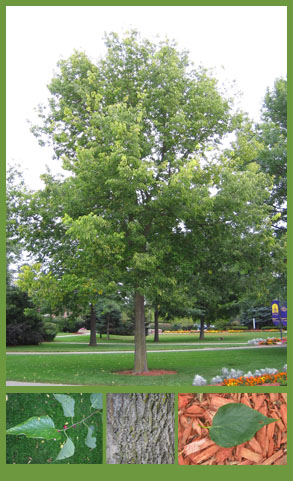Class: Magnoliopsida
Origin: Uticales
Family: Ulmaceae
The common Hackberry (Celtis occidentalis) also known as sugarberry, nettletree, beaverwood, northern hackberry, and American hackberry, occupies a range that starts in Northern New England, extends along the eastern sea board down to Florida then stretches to its western frontier along the eastern slope of the American Rockies. Native to the United States, the Hackberry’s classification as a dicot places it in the Class Magnoliopsida, subclass Hamamelidae. It is considered a member of the order Uticales as well as the elm family Ulmaceae. The genus Celtis L. includes 8 different species of hackberry including the common hackberry, Celtic occidentalis.
Normal sizes tend to vary depending on the quality of the environment. In arid conditions Hackberry may appear somewhat shrub-like while in more optimal conditions, the tree can reach sizes as large as 130 ft tall and 4 ft in diameter. The leaves are simple and alternate with a lance-ovate shape 2-4.5 in long and 1.2-2.4 in wide. Also characteristic is a serrate edge. Hackberry bark is thick, 1-1.5 in, dark brown or grey with deep furrows. The flowers bloom when the leaves emerge which generally occurs in mid-may in the northern extremities of its distribution. The small green flowers are unisexual and pollinated by wind.
The hackberry itself is a small round drupe with a thin edible layer covering a cream colored nut or seed. They range in color from dark orange to red to purple or black and are ripe from September through October. Most of the seed dispersion is accomplished by small birds and mammals. Twenty-five species of birds forage for and feed upon the hackberries, yet they offer very little nutritional value, lacking any considerable amount of protein. Deer and Elk may graze on the foliage but do not prefer this species to many others because of its bitter taste.
Four different gaul producing insects commonly make residence on hackberry trees including the spiny elm caterpillar, the hackberry butterfly caterpillar, the hackberry engraver beetle, as well as a mite, Eriophyes spp. The larva stages mature within gauls or small bubbles embedded within the leaves, eventually hatching and grazing on the foliage.
The hackberry wood is of medium density and relatively useless for lumber but can be utilized as exceptional firewood. Hackberry can also be used to reclaim forest in nutrient poor soil as it will live and bear fruits where other trees would not.
Back
|
 |